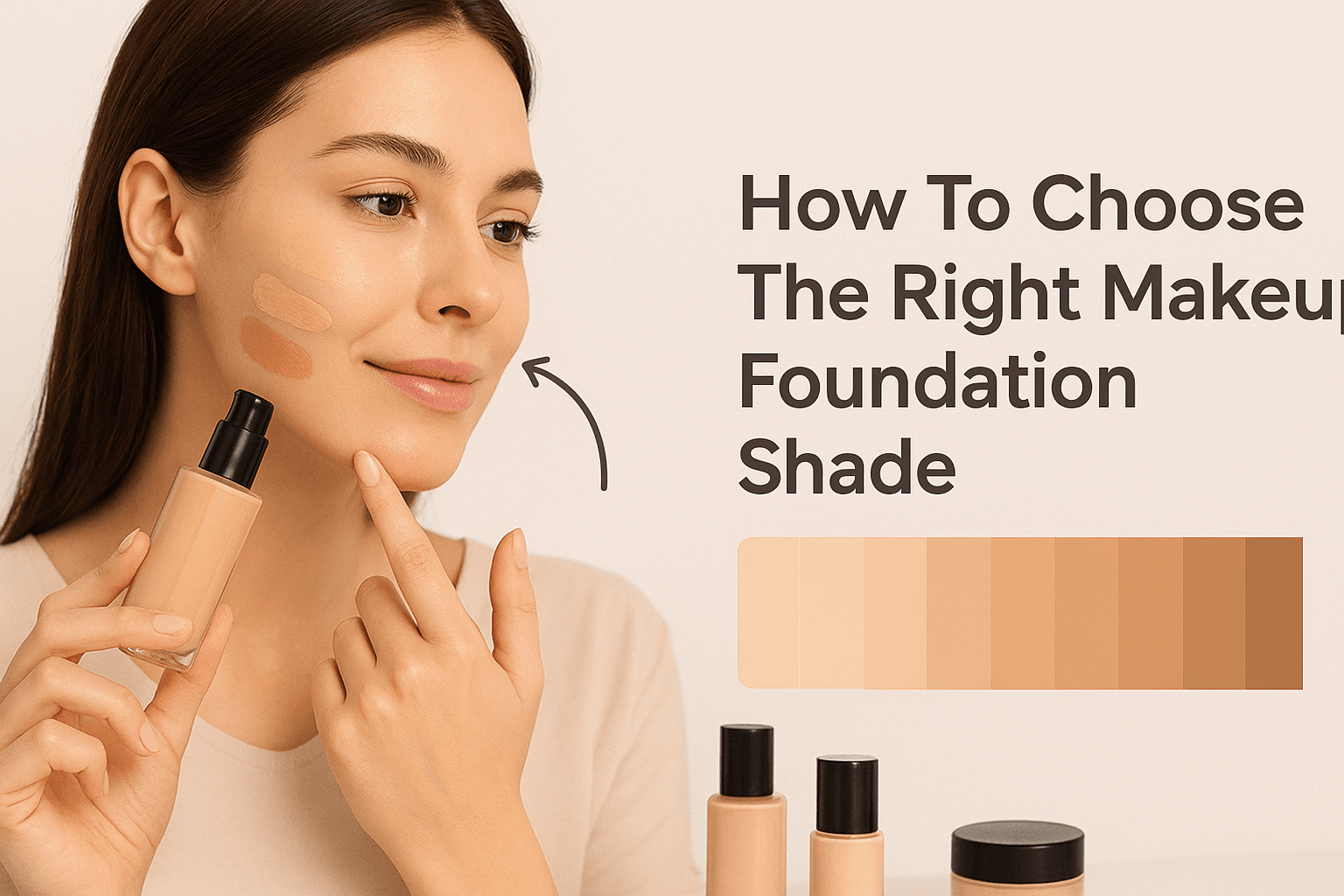Finding the perfect makeup foundation shade is one of the most crucial steps in achieving a flawless complexion. With thousands of foundation options available and the challenge of matching your unique skin tone, selecting the right shade can feel overwhelming. However, understanding your undertone and following proven color-matching techniques will help you find your ideal foundation match every time.
Understanding Your Skin Undertone: The Foundation of Perfect Matching
Your undertone is the subtle hue beneath your skin’s surface that remains constant regardless of sun exposure or skin changes. Identifying your undertone is essential for choosing a foundation shade that looks natural and seamless.
The Vein Test Method
Examine the veins on your wrist under natural light. Blue or purple veins indicate cool undertones, while green or olive-colored veins suggest warm undertones. If you see a mix of both colors, you likely have neutral undertones.
The Jewelry Preference Test
Notice which metal jewelry flatters your skin tone most. Silver typically complements cool undertones, while gold enhances warm undertones. If both metals look equally flattering, you probably have neutral undertones.
The White Paper Comparison
Hold a piece of white paper next to your clean, makeup-free face in natural light. If your skin appears yellow or golden against the paper, you have warm undertones. A pink or rosy cast indicates cool undertones, while minimal contrast suggests neutral undertones.
Sun Response Analysis
Consider how your skin reacts to sun exposure. Cool undertones typically burn easily and develop pink or red color, warm undertones tan easily with minimal burning, and neutral undertones experience a combination of both reactions.
Step-by-Step Foundation Shade Selection Process
Step 1: Identify Your Skin Type
Understanding your skin type influences both formula selection and shade choice. Oily skin often benefits from mattifying foundations that may appear slightly different than hydrating formulas on dry skin. Combination skin requires careful consideration of how foundation appears across different facial zones.
Step 2: Determine Your Coverage Needs
Your desired coverage level affects shade selection:
- Light coverage: Enhances natural skin tone with minimal color alteration
- Medium coverage: Provides even complexion while maintaining natural appearance
- Full coverage: Delivers maximum color payoff and may require precise shade matching
Step 3: Test Foundation Properly
Never test foundation on your hands, as hand skin differs significantly from facial skin in both color and texture. Instead, apply small amounts of potential shades along your jawline, blending each thoroughly.
Step 4: Evaluate in Natural Lighting
Indoor lighting can drastically alter how foundation appears. Always check your foundation match in natural daylight, preferably near a window or outdoors. Allow 5-10 minutes for the foundation to settle and oxidize before making your final decision.
Step 5: Consider Seasonal Variations
Your skin tone naturally fluctuates throughout the year due to sun exposure and environmental factors. Many people benefit from having two foundation shades: a lighter shade for winter months and a slightly deeper shade for summer. During transitional seasons, mixing these shades creates the perfect custom match.
Step 6: Assess Blending Quality
The ideal foundation shade disappears seamlessly into your skin without visible demarcation lines. If you can clearly see where the foundation begins and ends, or notice a stark contrast at your jawline or neck, consider adjusting your shade choice.
Step 7: Compare Multiple Options
Test three shades closest to your perceived skin tone simultaneously. Apply them in parallel stripes along your jawline and observe which one blends most naturally. The correct shade will virtually disappear into your skin.
Mastering Online Foundation Shopping
Digital Shade-Matching Tools
Many cosmetic brands offer sophisticated online shade finders that analyze your current foundation preferences and recommend equivalent shades across their product lines. These tools use extensive databases to cross-reference shades between different brands and formulas.
Virtual Try-On Technology
Advanced augmented reality features allow you to upload photos and virtually test foundation shades. Brands like MAC, Maybelline, and Nykaa provide realistic previews of how different shades appear on your complexion.
AI-Powered Matching Systems
Artificial intelligence algorithms analyze uploaded photos to determine your skin tone and undertone, providing personalized shade recommendations. These systems continuously learn and improve their accuracy through user feedback and vast complexion databases.
Smart Questionnaire Systems
Comprehensive online questionnaires gather detailed information about your skin characteristics, current products, and preferences to generate tailored foundation recommendations. These tools consider factors like skin type, undertone, coverage preferences, and lifestyle needs.
Common Foundation Matching Mistakes to Avoid
Testing on Incorrect Areas
Avoid testing foundation exclusively on your hands, inner wrists, or other body parts that don’t match your facial skin tone. These areas often have different undertones and color depth than your face.
Ignoring Oxidation Time
Foundation can change color after application due to oxidation and interaction with your skin’s natural oils. Always allow adequate time for the formula to settle before making purchasing decisions.
Overlooking Neck Matching
Your foundation should blend seamlessly from your face to your neck without creating visible color differences. Consider your neck’s undertone when selecting your foundation shade.
Seasonal Shade Rigidity
Sticking to one foundation shade year-round often results in mismatched color as your skin tone naturally fluctuates. Embrace seasonal shade adjustments for consistently flattering results.
Professional Foundation Matching Tips
The Triangle Test Method
Apply your potential foundation shade in a small triangle on your cheek, blending the edges. This technique shows how the shade interacts with your natural skin color in an area that’s representative of your overall complexion.
Color Correcting Considerations
Understanding color theory helps in foundation selection. If your skin has red undertones you want to neutralize, choose foundations with slight green undertones. For sallow or yellow skin, foundations with pink undertones can provide balance.
Formula and Finish Impact
Different foundation formulas can affect how the same shade appears on your skin. Matte foundations may appear slightly darker, while dewy formulas can look lighter and more luminous. Consider how your chosen formula affects the shade’s appearance.
Professional Consultation Benefits
When possible, seek assistance from trained makeup professionals who can objectively assess your skin tone and recommend appropriate shades. Their expertise and access to professional lighting can provide valuable insights.
Technology and Tools for Foundation Matching
Smartphone Apps with AR Capabilities
Mobile applications use your phone’s camera to scan and analyze your skin tone, providing real-time shade recommendations. These apps often include shopping integration for immediate purchase options.
Color Analysis Devices
Some beauty retailers offer professional color-matching devices that use spectrophotometry to precisely measure your skin tone and provide scientifically accurate shade recommendations.
Online Community Resources
Beauty forums and social media groups provide valuable crowdsourced information about foundation shades, with users sharing their skin tone details and successful matches across different brands.
Top 10 Best Makeup Foundations in India
| Rank | Brand | Foundation Name | Price Range (₹) | Coverage | Skin Type | Key Features |
|---|---|---|---|---|---|---|
| 1 | Maybelline | Fit Me Matte + Poreless | 499-699 | Medium-Full | Oily/Combination | Oil-free, 16-hour wear, wide shade range |
| 2 | L’Oréal Paris | True Match Foundation | 750-950 | Medium | All Skin Types | Tone-matching technology, natural finish |
| 3 | Lakme | 9to5 Weightless Mousse Foundation | 625-750 | Medium | Normal/Combination | Lightweight, 12-hour wear, SPF 15 |
| 4 | Nykaa | All Day Matte Foundation | 449-549 | Medium-Full | Oily/Combination | Transfer-proof, 24-hour wear, Indian skin tones |
| 5 | Sugar Cosmetics | Ace of Face Foundation Stick | 999-1,199 | Full | All Skin Types | Buildable coverage, easy application, travel-friendly |
| 6 | Colorbar | Perfect Match Foundation | 890-1,090 | Medium | Normal/Dry | Hydrating formula, natural finish, vitamin E |
| 7 | Revlon | ColorStay Makeup | 1,250-1,450 | Full | All Skin Types | 24-hour wear, oil-free, time-release technology |
| 8 | MAC | Studio Fix Fluid SPF 15 | 2,900-3,200 | Medium-Full | All Skin Types | Professional quality, extensive shade range, SPF protection |
| 9 | Faces Canada | Ultime Pro HD Foundation | 1,399-1,599 | Full | All Skin Types | HD finish, long-lasting, cruelty-free |
| 10 | MyGlamm | Flawless Liquid Foundation | 795-895 | Medium | Normal/Combination | Lightweight, natural finish, Indian brand |
Conclusion
Mastering foundation shade selection transforms your entire makeup routine and boosts your confidence. By understanding your undertone, utilizing proper testing techniques, and embracing both traditional and digital matching methods, you’ll consistently choose foundation shades that enhance your natural beauty. Remember that finding your perfect match is a skill that improves with practice and attention to detail.
Frequently Asked Questions About Foundation Shade Selection
When you’re between shades, purchase both and mix them to create your perfect custom match. This approach provides flexibility for seasonal skin tone changes and ensures optimal color matching year-round.
A foundation that’s too light will create an ashy, ghostly appearance and may emphasize skin imperfections. A shade that’s too dark will appear muddy or orange and create harsh contrast lines. The correct shade blends invisibly into your natural skin tone.
Most people benefit from slight shade adjustments between seasons due to natural skin tone fluctuations from sun exposure and environmental factors. Having seasonal options or mixing capabilities provides the most accurate matches year-round.
Your foundation should create a seamless transition between your face and neck. If there’s a significant color difference between these areas, choose a shade that splits the difference or use color-correcting techniques to create harmony.
Reevaluate your foundation shade seasonally or whenever you notice color mismatches. Factors like aging, sun exposure, skincare changes, and hormonal fluctuations can affect your skin tone over time.
Some people have varied undertones across their face, particularly around the T-zone or cheeks. In these cases, choose a foundation shade that works best for the majority of your face, and use color-correcting products to address specific areas as needed.



